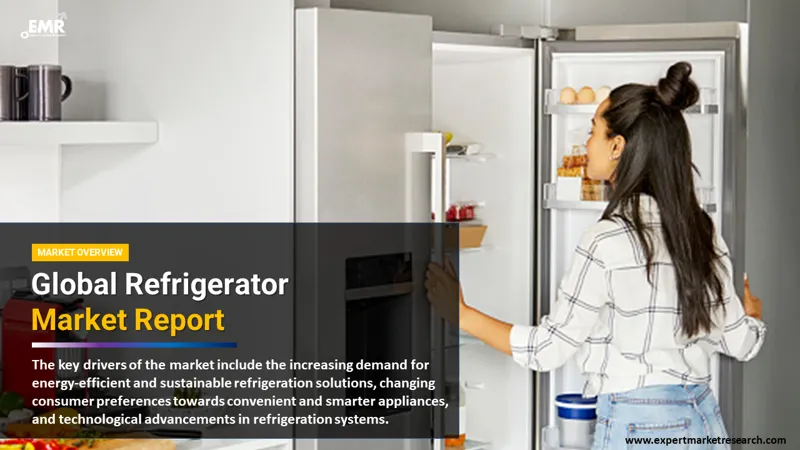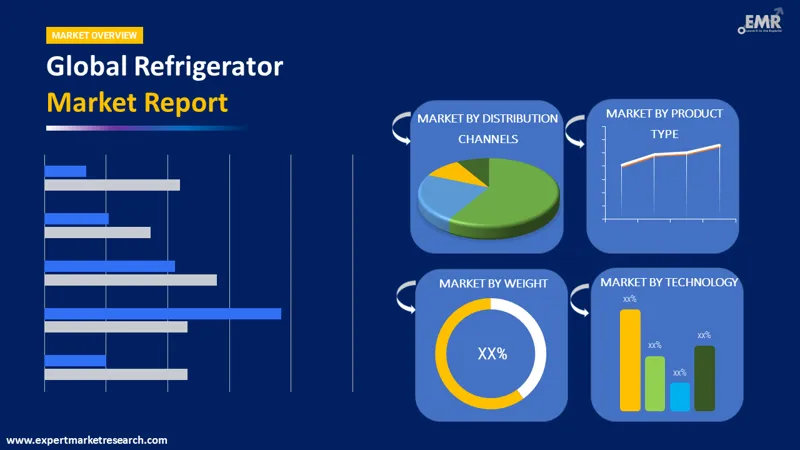
Consumer Insights
Uncover trends and behaviors shaping consumer choices today
Procurement Insights
Optimize your sourcing strategy with key market data
Industry Stats
Stay ahead with the latest trends and market analysis.
The global market size for refrigerators reached a value of more than USD 133.50 Billion in 2025. The global refrigerator market is expected to grow at a CAGR of 5.70% between 2026 and 2035, reaching a value of USD 232.40 Billion by 2035.
Base Year
Historical Period
Forecast Period
Compound Annual Growth Rate
5.7%
Value in USD Billion
2026-2035
*this image is indicative*
A refrigerator, commonly known as a fridge, has become an essential home appliance used to store and preserve food items that are perishable. Refrigerant tetrafluoroethane is used in refrigerators which changes from liquid to gas and cools the surrounding area, creating a desirable surrounding. It has five main working parts including a condenser, refrigerant, compressor, expansion valve, and evaporator.

Read more about this report - REQUEST FREE SAMPLE COPY IN PDF

Read more about this report - REQUEST FREE SAMPLE COPY IN PDF
The EMR’s report titled “Global Refrigerator Market Report and Forecast 2026-2035” offers a detailed analysis of the market based on the following segments:
Breakup by Technology
Breakup by Product Type
Breakup by Weight
Breakup by Distribution Channels
Breakup by Region
According to refrigerator market research, speciality retailers give a full demo before selling the product which tends to satisfy concerns of customers and are hence preferred by many consumers. Refrigerators are easily available at supermarkets and buyers can check every detail giving a sense of satisfaction while buying the product. Online stores have also gained popularity because of the offers and discounts that are provided with return options available too. The wide range of purchasing options available are surging the global refrigerator market size. With increasing availability and accessibility of refrigerators across various distribution channels, consumers are more likely to purchase new and improved models of refrigerators.
Asia Pacific is projected to dominate the market with a larger refrigerator market share due to its vast population and increase in individual households. The region's growing need for infrastructure will enhance the demand for home appliance products. Strong demand for smart appliances to replace traditional appliances, rising disposable income, rapid urbanisation, and the growing number of households are additional key factors propelling market expansion in the Asia Pacific.
Additionally, the region is a manufacturing hub with the headquarters of many top industry players, including Panasonic Corp., LG Electronics, Samsung, and Haier Group. Programmes by governments in developing nations like Bangladesh, India, Nepal, Indonesia, and the Philippines to electrify rural areas would help the regional market expand. The commercial refrigeration market share is also expected to expand in the Asia Pacific, with an increasing number of restaurants and food service businesses opening in the region.
North America is projected to hold a significant portion of the market due to the rise in disposable income in countries like the United States and Canada. The US refrigerator market share is relatively large as families tend to buy groceries in bulk, utilising large refrigerators for high volume grocery storage. Additionally, factors like the region's massive metropolitan population base will encourage more people to use such equipment. This will likely increase the US refrigerator market size. The growing trend of meal planning in the United States, with working people preparing meals in advance and freezing them for instant use, is also expanding the U.S. refrigerator market size.
The comprehensive EMR report provides an in-depth assessment of the market based on the Porter's five forces model along with giving a SWOT analysis. The report gives a detailed analysis of the following key players in the global refrigerator market, covering their competitive landscape and latest developments like mergers, acquisitions, investments, and expansion plans.
LG Electronics Inc. founded in 1958 has its headquarter in Seoul, South Korea. It is known worldwide and is a global leader in manufacturing commercial products including TVs, monitors, home appliances, service robots, and air solutions.
Haier Group is a leading producer of daily use appliances and was founded in 1984 with headquarters in China. With continued collaborations with ecosystem partners, the group has a vision to build IoT ecosystems for customers globally.
Whirlpool Corporation is known for developing appliances such as ACs, refrigerators, washing machines, and microwaves. It was established in 1911 and has its headquarters in Michigan, in the United States.
*Please note that this is only a partial list; the complete list of key players is available in the full report. Additionally, the list of key players can be customized to better suit your needs.*
Other market players include Samsung Electronics Co., Ltd., Hitachi Ltd., Electrolux AB, Panasonic Corporation, BSH Home Appliances Corporation, Miele & Cie. KG, Arçelik A.Ş, Toshiba Corporation, Midea Group, Honeywell International Inc, Godrej & Boyce Manufacturing Company Limited, and Sharp Electronics Corporation, among others.
United States Refrigerator Market
North America Refrigerator Market
United Kingdom Refrigerator Market
Australia Smart Refrigerator Market




*While we strive to always give you current and accurate information, the numbers depicted on the website are indicative and may differ from the actual numbers in the main report. At Expert Market Research, we aim to bring you the latest insights and trends in the market. Using our analyses and forecasts, stakeholders can understand the market dynamics, navigate challenges, and capitalize on opportunities to make data-driven strategic decisions.*
Get in touch with us for a customized solution tailored to your unique requirements and save upto 35%!
The global market size for refrigerators reached a value of more than USD 133.50 Billion in 2025.
The market is expected to reach a value of USD 232.40 Billion by 2035.
The market is expected to grow at a CAGR of 5.70% between 2026 and 2035.
The major market drivers are longer durations between grocery shopping trips, smarter features, and versatile storage options.
Major trends of the market include technological advancements, and glass doors.
The major regional markets are North America, Europe, the Asia Pacific, Latin America, and the Middle East and Africa.
Key players for the global refrigerator market are LG Electronics Inc., Haier Group, Whirlpool Corporation, Samsung Electronics Co., Ltd., Hitachi Ltd., Electrolux AB, Panasonic Corporation, BSH Home Appliances Corporation, Miele & Cie. KG, Arçelik A.S, Toshiba Corporation, Midea Group, Honeywell International Inc, Godrej & Boyce Manufacturing Company Limited, and Sharp Electronics Corporation, among others.
A refrigerator, commonly known as a fridge, is an common home appliance used to store and preserve food items that are perishable.
The market is segmented based on product type, technology, weight, distribution channel and region.
Tetrafluoroethane gas is commonly used in refrigerators.
Explore our key highlights of the report and gain a concise overview of key findings, trends, and actionable insights that will empower your strategic decisions.
| REPORT FEATURES | DETAILS |
| Base Year | 2025 |
| Historical Period | 2019-2025 |
| Forecast Period | 2026-2035 |
| Scope of the Report |
Historical and Forecast Trends, Industry Drivers and Constraints, Historical and Forecast Market Analysis by Segment:
|
| Breakup by Technology |
|
| Breakup by Product Type |
|
| Breakup by Weight |
|
| Breakup by Distribution Channels |
|
| Breakup by Region |
|
| Market Dynamics |
|
| Trade Data Analysis |
|
| Competitive Landscape |
|
| Companies Covered |
|
Datasheet
One User
USD 2,499
USD 2,249
tax inclusive*
Single User License
One User
USD 3,999
USD 3,599
tax inclusive*
Five User License
Five User
USD 4,999
USD 4,249
tax inclusive*
Corporate License
Unlimited Users
USD 5,999
USD 5,099
tax inclusive*
*Please note that the prices mentioned below are starting prices for each bundle type. Kindly contact our team for further details.*
Flash Bundle
Small Business Bundle
Growth Bundle
Enterprise Bundle
*Please note that the prices mentioned below are starting prices for each bundle type. Kindly contact our team for further details.*
Flash Bundle
Number of Reports: 3
20%
tax inclusive*
Small Business Bundle
Number of Reports: 5
25%
tax inclusive*
Growth Bundle
Number of Reports: 8
30%
tax inclusive*
Enterprise Bundle
Number of Reports: 10
35%
tax inclusive*
How To Order

Select License Type
Choose the right license for your needs and access rights.

Click on ‘Buy Now’
Add the report to your cart with one click and proceed to register.

Select Mode of Payment
Choose a payment option for a secure checkout. You will be redirected accordingly.
Gain insights to stay ahead and seize opportunities.

Get insights & trends for a competitive edge.

Track prices with detailed trend reports.

Analyse trade data for supply chain insights.

Leverage cost reports for smart savings

Enhance supply chain with partnerships.

Connect For More Information
Our expert team of analysts will offer full support and resolve any queries regarding the report, before and after the purchase.
Our expert team of analysts will offer full support and resolve any queries regarding the report, before and after the purchase.
We employ meticulous research methods, blending advanced analytics and expert insights to deliver accurate, actionable industry intelligence, staying ahead of competitors.
Our skilled analysts offer unparalleled competitive advantage with detailed insights on current and emerging markets, ensuring your strategic edge.
We offer an in-depth yet simplified presentation of industry insights and analysis to meet your specific requirements effectively.
Share